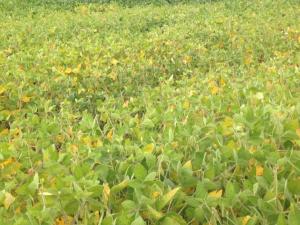September 14, 2017

By Alan Sundermeier, CCA
As soybeans are maturing, an opportunity to establish an early cover crop is available. If a farmer waits until after soybean harvest, then many days of growth are being wasted.
Soybeans should have dropped 10% of their leaves before seeding a cover crop. Planting too early and the cover crop may have too much growth and interfere with combine operation and green material separation. Waiting too late will place the seed on top of fallen leaves and not contact the soil properly. The idea is to place the seed on the soil, then have soybean leaves cover and mulch the cover crop seed to enhance germination.
Cover crops can be aerial seeded by plane or helicopter. Use an experienced pilot who can calibrate the application and control seed drop location. Also a high clearance sprayer can be used that is adapted for seed delivery. Following tram lines will lessen the damage to soybeans from wheel tracks.
Germination success may be more difficult with broadcast seeding versus drilling or planting. Therefore, seeding rates may need to be increased about 25% to result in a similar stand of cover crops compared to drilled. Ideally, seeding before a rainfall will get the cover crops off to a quick start.
Species like brassicas (radish), oats, buckwheat, and other frost sensitive cover crops need to be seeded before soybean harvest to ensure enough growing time before killing frost. Frost tolerant species such as cereal rye (at 1-2 bushel per acre) can be seeded into late fall. A mixture of cover crop seed such as ; radish, crimson clover, and oats would do well seeded into standing soybeans. A rate of 2 pounds radish, 15 pounds crimson clover, and 30 pounds oats per acre are minimum for soil coverage.
Annual ryegrass (at 30-60 pounds per acre) will also do well seeded into standing soybeans. Topgrowth is less than cereal rye yet root growth is deeper and more aggressive that cereal rye. With any cover crop that overwinters, have a plan in place for termination next spring.
Large seed size, such as Austrian Winter Pea, do not do well broadcast seeded. Large seeded cover crops need to be incorporated into the soil for better seed/soil contact for germination.
You May Also Like




